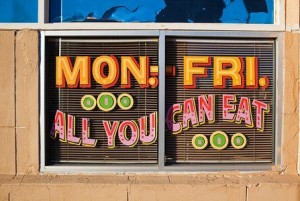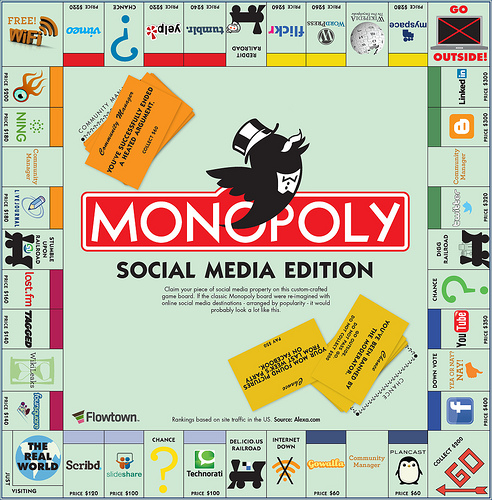
It’s a Bargain! All You Can Eat For…
How did you choose what was going on your Social Media menu?
Did you take the ‘I’ll just dive in’ path (like the folks who run towards a buffet thinking they’re never going to eat again), consuming all that’s available, as quickly as possible?
Did you head into using social networking, before plunging into answering ‘why am I using social media‘?
What have you piled on your virtual plate?
- A bit of Twitter?
- Chunk of Facebook?
- Slice of Google+, just to try it?
- Squeezing in social bookmarking?
- Found a small space for forums (they do still exist)?
- Nibbling away on LinkedIn?
- Pinterest made it to your plate?
- Morsels of blogging, photo sharing, YouTube?
- And that’s just the first helping…
Once you got that all balanced sky high, did you then add the sizzling hot new tools available that you’ve never tasted before, trying to cram them on top of what’s already looking a little precarious?
Uneven. Wobbly. Balancing act. Going to land on the floor any minute.
Your social networking – have you managed to maintain them all?
Or
Do you miss a one week, then pick up the next? Leave it for months, then dive in for a few days, get busy, and then leave again. Do you read posts such as ‘200 New Social Media Tools to Use for Your Business’ and then try to apply at least half in the space of an afternoon?
Are you that hungry?
The Social Media Smorgasbord
(I know, I could’ve used ‘buffet’, but Smorgasbord sounded far snazzier)
Would you look at it…

Have you had a chance to actually enjoy the meal?
Have you been too busy devouring and absorbing the tools to actually stop, sit down and share?
‘They’ say a meal is best enjoyed in the company of others. Have you sat down at the virtual table?
(Assuming you aren’t ‘collecting’ people, just so they can be at your social media party. No, sorry, collecting 5,000 ‘friends’ on Facebook or 7,000 Twitter followers does not mean it’s going to be a great event!)
Pigging Out
A few months ago now, I realised I’d overdone it. I knew I should not have had that last portion of ‘please confirm your email subscription’.
I’d been too busy up at the social media buffet table trying to figure out what would satisfy my appetite and fulfil my needs: tasting and adding whatever new ‘dish’ was being produced, stuffing my face, without actually stepping back and trying to manage what I already had on my plate.
Time for a diet. Detox. Colonic Flush Thing.
Introducing the Social Media Diet
Basically, it’s simple
Do more of what works, less of what doesn’t.
Here’s the diet sheet:
Weigh In First: explore where you’re at, you’re skills, what you need, the ‘why’, what you can manage.
Quit The Binging and Gorging — you’re a solo business owner, you don’t need to use all the tools, or jump on the next new dish. Eat only what you can physically consume (time and money).
Know When You’re Sufficiently Full — as a solo business owner, do you really need to be the leader in social media? Unless of course you work in social media, then you do.
Seriously, what are you, the New York Times? Reuters?
When you’re full.
Stop.
Digest what you’ve taken in. Then move on to the next course.
Social Media Isn’t Free — it may appear that way, it’s not. It costs you time and money. Just spend it wisely, that’s all I’m saying.
Oh, remember social networking and social media are as different as night and day.
Huh?
Explain?
Okay, let’s assume you’re a local restaurant owner and you’re using social networking tools as part of your social media marketing. Let’s use Facebook for the example, you post:
- You say ‘Just heading out for a meal‘. Great, people know you are going out for a meal. Networking, sure. Closed conversation though.
- You may say ‘Just heading out for a meal, can anyone recommend a good restaurant‘. Networking, displaying you’re interested, encouraging conversation.
- You could say ‘Just heading out for a meal, anyone know a great restaurant, what’s their website address so I can check it out?‘. Networking, conversation, sharing, interest, open conversation.
- You could say ‘Just heading out for meal, what’s your favourite restaurant, any dishes you’d like to see on our menu?‘ Networking, conversation, sharing, listening, asking for feedback. (You could then go on and add it to the menu, for one night only, offering 50% off for the people who commented on the post!)
Size of The Meal — just remember you work alone, chances are you don’t have a marketing department! You are the department. Use what works. Choose the meal that has all the portions that fit your business.
Join The Table — have the conversations, connect, listen, share.
Photo Credit: Emilie Ogez (thank you)
PS: This is the stuff that makes me giggle. Making sure I had spelt ‘colonic’ correctly, I checked, and in the adverts this:





 A man would do nothing if he waited until he could do it so well that no one could find fault. John Henry Newman
A man would do nothing if he waited until he could do it so well that no one could find fault. John Henry Newman
